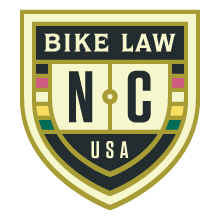It’s important to know your legal rights (and duties) when bicycling in North Carolina. It is especially important after a bicycle accident (we call them bicycle “crashes” and explain why here).
This is a general overview of North Carolina’s bicycle laws. To see them in their completion, please visit North Carolina’s Department of Transportation or for a more in-depth analysis of North Carolina bicycle laws, please refer to the North Carolina Ride Guide. For any questions about this State’s bike laws, the NC Ride Guide. or about your rights to the road, contact North Carolina’s Bike Law Attorney Ann Groninger directly.
Right to the Road
Bicycles are defined as vehicles and generally have the same rights and responsibilities as motor vehicle drivers.
Where to Ride
- Bicyclists traveling less than the legal speed limit must ride in the right-hand lane then available for thru traffic or as close as practicable to the right hand curb or edge of the highway, except when overtaking and passing another vehicle or preparing for a left turn.
- Bicyclists may, but are not required to, utilize any usable path for bicycles that has been provided adjacent to a roadway.
- Bicycles are permitted on the sidewalks in many municipalities, except in center city areas. Check local ordinances for variations on this rule.
HOW TO RIDE
- Bicyclists may generally ride two abreast but bicyclists should check their local ordinances for variations of this rule.
- Bicyclists are required to slow down and come to a complete stop at stop signs and traffic devices signaling red. If the bicyclist cannot trigger or trip a traffic signal, they may treat it as a broken signal and stop until the way is clear to proceed.
- Bicyclists must signal when turning or coming to a stop.
Bicyclists Overtaking Cars
Bicyclists on roadways must exercise due care when passing a standing vehicle or one proceeding in the same direction and may pass a motor vehicle on the right only if a motor vehicle could legally make a similar maneuver.
Cars Overtaking Bicyclists
Motor vehicle drivers are required to pass bicyclists with at least two (2) feet clearance to the left. Drivers may also cross the double yellow line to pass bicyclists where there is enough sight distance to do so and the motorist allows at least four (4) feet to the left or the motorist completely enters the opposite lane to pass.
Equipment
- Bicyclists under the age of 16 are required to wear a properly fastened helmet.
- At night, a bicycle must be equipped with a front white headlight visible from 300 feet away and a rear red reflector and either a light or reflective clothing visible from 300 feet away.
Prohibitions
- Unsanctioned bicycle racing is not prohibited.
Alcohol
- North Carolina’s Driving while Impaired (DWI) statute does apply to bicyclists as bicycles are defined as vehicles.
If you are in need of representation in North Carolina contact one of our Bike Accident Lawyers in your area.
Raleigh Bike Crash Attorney
Durham Bike Crash Attorney
Charlotte Bike Crash Attorney
